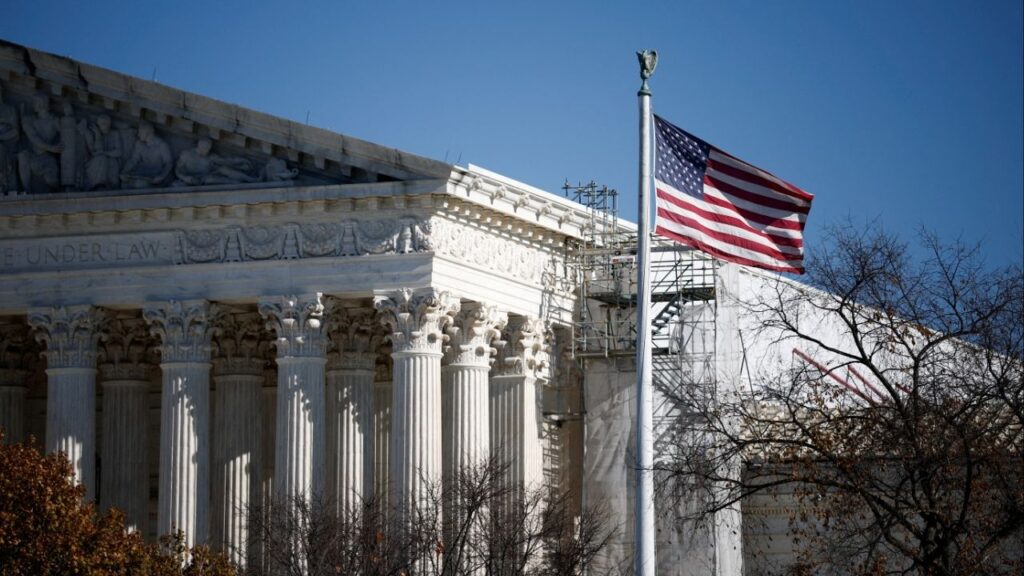Reporters work outside of the Supreme Court in Washington, Thursday, June 27, 2024. The Supreme Court said on Thursday that it would dismiss a case about emergency abortions in Idaho, temporarily clearing the way for women in the state to receive an abortion when their health is at risk. (Jason Andrew/The New York Times)

- Recent Supreme Court rulings on abortion were criticized for avoiding decisive action, potentially setting the stage for future restrictions.
- Scholars foresee continued legal battles over abortion rights amid a lack of clear national guidelines post-Roe v. Wade.
- The court's cautious approach, especially in an election year, hints at sensitivity to political factors influencing abortion litigation.
Share
|
Getting your Trinity Audio player ready...
|
WASHINGTON — Superficially, abortion rights had a good run at the Supreme Court this term. Two weeks ago, the justices unanimously let an abortion pill remain widely available. On Thursday, the court dismissed a case about Idaho’s strict abortion ban, which had the effect of letting emergency rooms in the state perform the procedure when the patient’s health is at risk.
But the two rulings were so technical as to be ephemeral. They seemed designed for avoidance and delay, for kicking a volatile subject down the road — or at least past Election Day.
Some supporters of abortion rights called the rulings Pyrrhic victories, ones they feared would set the stage for more restrictions, whether from the courts or from a second Trump administration.
Dobbs v. Jackson Women’s Health Organization
In Dobbs v. Jackson Women’s Health Organization, the 2022 decision that overturned Roe v. Wade, the Supreme Court signaled that it sought to get out of the abortion business. “The authority to regulate abortion must be returned to the people and their elected representatives,” Justice Samuel Alito wrote for the majority.
The two recent rulings were generally consistent with that sentiment, though Alito himself was eager to address Thursday’s case. “Apparently,” he wrote, “the court has simply lost the will to decide the easy but emotional and highly politicized question that the case presents. That is regrettable.”
The majority took a different view, but its strategy of evasion cannot last, said Mary Ziegler, a law professor at the University of California, Davis.
Related Story: The Supreme Court Weakens Federal Regulators, Overturning Decades-Old Chevron ...
“What is clear, both in this term and in what is likely to come next, is that the abortion struggle is not being left to the states,” she said. “The executive branch and the Supreme Court are still very much going to have their say.”
David S. Cohen, a law professor at Drexel University, said the end of Roe was the beginning of a war in which each side seeks total victory. That means, he said, that the Supreme Court will not be able to duck hard issues in the long term.
“In both of these cases,” he said of this month’s decisions, “the court avoided tackling the morass created by overturning Roe v. Wade. Without a national right to abortion care, contentious cases like these are going to come back to the court again and again. The court won’t be able to sidestep its self-imposed mess forever.”
He added: “Neither side in this debate is going to stop fighting for their preferred outcome — a national rule applicable everywhere. So there is no doubt that we’re going to see more and more cases like this bubbling up to the Supreme Court in the coming years.”
Two Rulings Resolved Near Nothing
The two rulings resolved almost nothing.
The first said merely that the particular doctors and groups challenging the Food and Drug Administration’s approval of an abortion pill had not suffered the sort of injury that gave them standing to sue. The court did not rule on whether the agency’s action was lawful.
Other challengers, notably three states that have already intervened in the case in the trial court — Idaho, Kansas and Missouri — will continue to fight. Their challenge could reach the Supreme Court fairly quickly.
The Idaho case was even more of a nonevent. The court, which had taken the unusual step of agreeing to review a trial judge’s ruling before an appeals court had acted, thought better of getting involved at such an early stage.
Related Story: Supreme Court Allows Cities to Enforce Bans on Homeless People Sleeping Outside
The court dismissed the case as “improvidently granted,” the judicial equivalent of saying “never mind.” After the appeals court, the 9th U.S. Circuit Court of Appeals, rules, the Supreme Court may return to the case.
Or it might hear an appeal involving a broadly similar Texas law, which has been sustained by the 5th Circuit. The Biden administration has already filed a petition seeking review of that ruling.
“Both decisions strike me as Pyrrhic victories for the Biden administration,” Ziegler said. In the abortion-pill case, Food and Drug Administration v. Alliance for Hippocratic Medicine, she said, the court interpreted conscience protections for doctors opposed to abortion far more broadly than it had in earlier decisions.
Moyle v. United States
In the case on emergency abortions, Moyle v. United States, Ziegler said, Justice Amy Coney Barrett “likewise hinted at the importance of conscience protections and expressed suspicion of mental health justifications for abortion — both of which could be consequential in the future.”
Rachel Rebouché, dean of Temple University Beasley School of Law, said that “these decisions can’t be described as pure wins for abortion supporters.”
“The issues at the heart of both cases are sure to come before the court again,” she said. “The court didn’t rule on the merits in either decision, and there are already cases in the pipeline to test the legality of mailed medication abortion and to uphold state abortion laws that make no exception for avoiding serious injury or threat to health.”
The coming election may have played a role in the Supreme Court’s failures to act. After all, the Dobbs decision, issued months before the 2022 midterm elections, was a political windfall for Democrats.
Related Story: Supreme Court Blocks Enforcement of EPA’s ‘Good Neighbor’ ...
Greer Donley, a law professor at the University of Pittsburgh, said the court’s conservative majority may have wanted to avoid “an unpopular merits-based abortion decision in an election year.”
Ziegler said she was not sure how the election figured in the court’s calculations.
“It would have been extraordinary for the court to issue two major rulings in an election year, and it’s fair to assume that the court’s most institutionalist justices were looking for a way to avoid that outcome,” she said. “At the same time, there were real reasons to postpone ruling on the merits in either case.”
She added: “That means there isn’t a smoking gun pointing to this being an election-year about-face — after all, why take these cases in an election year in the first place? — but it seems quite likely that the upcoming election made it even more attractive to kick the can down the road.”
–
This article originally appeared in The New York Times.
By Adam Liptak/Jason Andrew
c.2024 The New York Times Company
Distributed by The New York Times Licensing Group
RELATED TOPICS:
Categories

MAHA Activists Urge Trump to Fire His EPA Administrator

Meta Strikes Multiple AI Deals With News Publishers

















